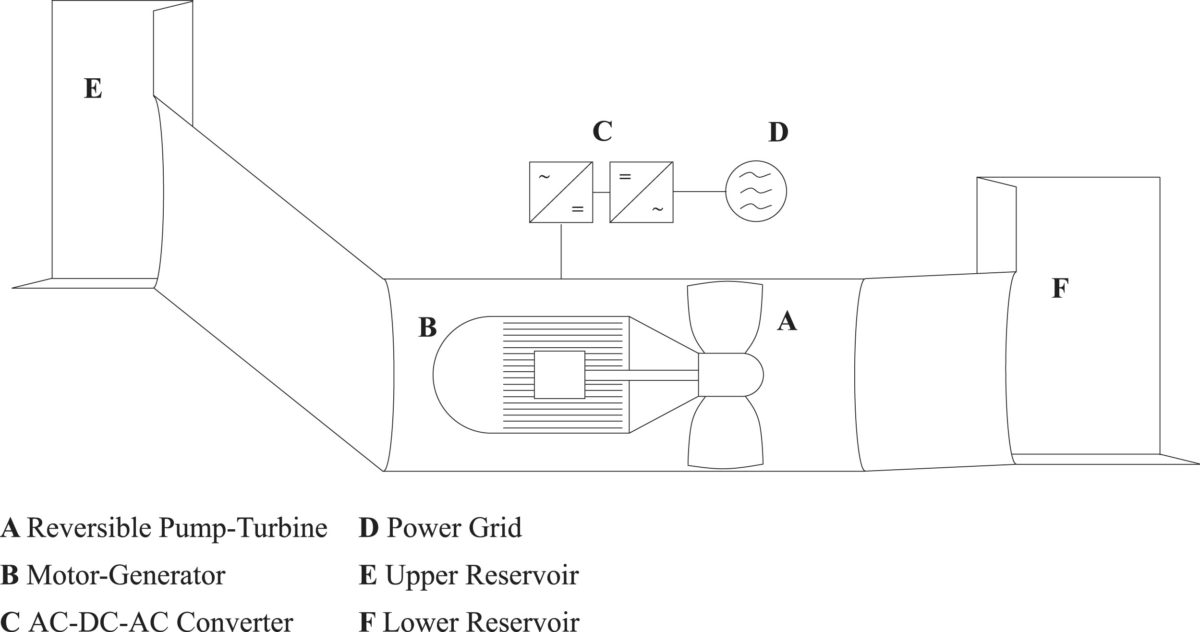Low-head pumped hydro storage (PHS) is a storage technology that has had a very limited development to date compared to conventional high-head pumped hydro technologies, mostly because of high upfront costs, a high levelized cost of storage (LCOS), and limited flexibility to provide ancillary services. Low-head projects, however, may be more sustainable in terms of environmental impacts and could be developed in regions without natural elevation differences available that are unsuitable for high-head projects.
With this in mind, two different research groups have provided, in separate analyses, an extensive overview of how this storage technology may get closer to commercial viability. “Low-head pumped hydro storage projects have been designed but never constructed,” reads one of the two papers.
Low-head hydropower and the related option for deploying pumped hydro storage refers to facilities where the head, which is the distance between the hydro intake water level and the water level at the point of discharge, is typically less than 20 meters.
In the paper Low-head pumped hydro storage: A review of applicable technologies for design, grid integration, control and modelling, published in Renewable and Sustainable Energy Reviews, a European research group has explained that low-head PHS could approach commercial feasibility by offering a storage capacity able to provide balancing in the timescale of hours to days, which would places this technology in the middle between lithium-ion storage for short-term storage and hydrogen for long-term storage.
The researchers identified three main areas where improvements should be made to make low-head PHS technically and economically competitive: Pump-turbine design and configuration; grid integration; and electrical machines and control.
As for the first aspect, the scientists pointed out that the choice of pump-turbine design is strictly dependent on the overall flow rate of the system, with axial flow pump-turbines being indicated as the most suitable option for high flow rates, which leads to higher power outputs.
For the grid integration, they concluded that the combination of grid-forming control alongside bulk energy storage will be crucial for the future adoption of low-head PHS. “To ensure grid stability, such systems will need to provide synthetic inertia next to other ancillary services, namely steady state voltage control, fast reactive current injections, short circuit currents, black start, and island operation capability,” they stated.
Popular content
Referring to the third area, the academics found that axial flux permanent magnet synchronous machines (PMSMs) are the most promising electric machines for low-head PHS due to their high efficiency, high power density, and suitability for high-torque-low-speed operation.
“There are considerable opportunities for further research to improve low-head pumped storage technology and facilitate economic viability,” the research group concluded. “Firstly, a detailed economic analysis incorporating a predicted increase in revenue from energy arbitrage and the provision of AS combined with improved control strategies optimized for these may serve as a further proof of concept.” The group includes academics from the Delft University of Technology in the Netherlands, the Chalmers University of Technology in Sweden, the Norwegian University of Science and Technology, the Technische Universität Braunschweig in Germany, and the Ghent University in Belgium.
In the second study, entitled Low-head pumped hydro storage: A review on civil structure designs, legal and environmental aspects to make its realization feasible in seawater and also published in Renewable and Sustainable Energy Reviews, other researchers investigated how low-head PHS may be deployed in shallow seas or integrated into coastal defenses.
According to their analysis, the most important factors to consider in developing similar projects should be assessing new reversible pump-turbine technology, the maintenance of electrical and mechanical components in seawater, methods for identifying adequate locations, ecological and morphological effects as well as the construction of innovative structures and dealing with legislation of different regions. Floating solar was also identified as a technical solution that could provide a mutual benefit with hydropower reservoirs by reducing evaporation while also cooling down solar module temperatures.
The scientists found the low-head PHS in shallow seawater may achieve an LCOS of between €40/MWh and €140/MWh. “Thus it is shown that low-head SPHS can be a competitive technology for integrating variable renewable energies into the grid,” they concluded.
This research group comprises researchers from the Technische Universität Braunschweig and the Universität Stuttgart in Germany, the Delft University of Technology, and the University of Tuscia in Italy, among others.
This content is protected by copyright and may not be reused. If you want to cooperate with us and would like to reuse some of our content, please contact: editors@pv-magazine.com.



1 comment
By submitting this form you agree to pv magazine using your data for the purposes of publishing your comment.
Your personal data will only be disclosed or otherwise transmitted to third parties for the purposes of spam filtering or if this is necessary for technical maintenance of the website. Any other transfer to third parties will not take place unless this is justified on the basis of applicable data protection regulations or if pv magazine is legally obliged to do so.
You may revoke this consent at any time with effect for the future, in which case your personal data will be deleted immediately. Otherwise, your data will be deleted if pv magazine has processed your request or the purpose of data storage is fulfilled.
Further information on data privacy can be found in our Data Protection Policy.